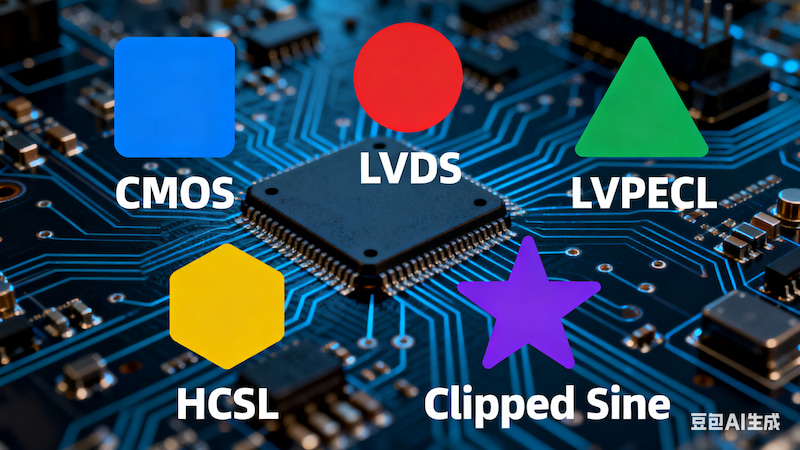In the realm of high-speed digital circuit design and system integration, the crystal oscillator acts as the system's "heartbeat." The quality of its output signal is paramount, directly determining the overall system's stability and performance. However, navigating the myriad of output types listed in datasheets—CMOS, LVDS, LVPECL, HCSL, and Clipped Sine—can be a common source of confusion for engineers. This article provides an in-depth comparison of these five primary oscillator output types, empowering you to make the perfect choice for your next project and ensure an optimized, highly reliable system design.

Understanding Output Logic: From General-Purpose to Specialized Solutions
Fundamentally, we can categorize these outputs into two main families: single-ended and differential CMOS/LVCMOS output oscillators and Clipped Sine wave oscillators fall under single-ended signals. They feature simple circuit structures and are the ideal choice for low-power clock oscillators and general-purpose microcontroller clock sources, dominating in cost-sensitive consumer electronics where frequencies are not extremely high. However, single-ended signals are susceptible to noise and show their limitations in high-speed, long-distance transmission. This is where differential signaling technology shines. LVDS differential oscillators, LVPECL clock oscillators, and HCSL output clocks all utilize a pair of opposite-phase signals for transmission, offering superior common-mode noise rejection, lower electromagnetic radiation (EMI), and excellent low jitter characteristics. They are the definitive solution for challenging EMI environments and enhanced signal integrity.
The Differential Face-Off: Application Territories of LVDS, LVPECL, and HCSL
Although all are differential outputs, LVDS, LVPECL, and HCSL each have their own distinct design and application strengths. LVDS crystal oscillators are known for their very low power consumption and moderate speed, making them the preferred choice for FPGA high-speed interface clocks, flat-panel display drivers, and clocks for high-speed data converters. They provide a stable, low-jitter reference clock while effectively controlling overall system power. LVPECL oscillators, on the other hand, represent the peak of performance, offering the fastest switching speeds and best jitter performance, but at the cost of higher power consumption and more complex termination networks. They are typically used in areas with extremely stringent timing requirements, such as network communication equipment clocks, optical modules, and base stations. Meanwhile, the HCSL output type is almost exclusively the standard configuration for PCIe clock generators. Its specific current-steering structure provides the PCI Express bus with a clock signal featuring sharp edges and ultra-low jitter, making it an indispensable clock component in hardware like motherboards, graphics cards, and solid-state drives (SSDs).
The Elegant Solution for Specialized Scenarios: Clipped Sine Wave
Among the plethora of square wave outputs, the Clipped Sine wave oscillator is a unique presence. It outputs a shaped sinusoidal wave whose harmonic content is significantly lower than that of a square wave, thereby substantially reducing electromagnetic interference. This low EMI crystal oscillator is primarily used in RF circuit clocks and as a local oscillator (LO) source for microwave systems, providing a "clean" clock signal to sensitive analog circuits and preventing digital noise from contaminating high-frequency analog signals.
Precise Selection Guide: Matching the Perfect "Heartbeat" to Your Project
Selecting the right crystal oscillator is a critical step for project success. If your design is for an industrial control mainboard or an IoT device core board with strict cost and power constraints, then a CMOS/LVCMOS output oscillator in a 3225 package crystal or a 2520 chip oscillator will be an economical choice. If you are designing a high-speed serial communication card or working on server clock distribution circuits, LVDS is the most versatile differential option due to its balanced performance. For designs that must comply with PCIe Gen 3/4/5 clock specifications, you must select an oscillator with an HCSL output. And for any application involving a high-frequency RF sampling clock, Clipped Sine output should be prioritized to ensure minimal system noise.
In conclusion, no single output type is a universal solution. Understanding the universality of CMOS, the balance of LVDS, the high performance of LVPECL, the specialization of HCSL, and the low noise of Clipped Sine is fundamental to making the best technical decision. As a professional crystal oscillator supplier, we offer a full range of high-stability active crystal oscillators and programmable oscillators to help you effortlessly meet a wide array of demanding design challenges.
Want to know more about A-Crystal’s Technology products?
Need selection the model or technical consultation?
Feel free to contact us via the following methods!
Tel: 0086-576-89808609
Email: market@acrystals.com
Website: [www.acrystals.com](http://www.acrystals.com)